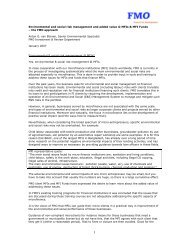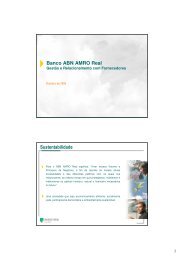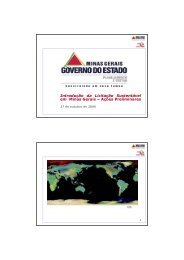From the forest to the consumer - GVces - Fundação Getulio Vargas
From the forest to the consumer - GVces - Fundação Getulio Vargas
From the forest to the consumer - GVces - Fundação Getulio Vargas
Create successful ePaper yourself
Turn your PDF publications into a flip-book with our unique Google optimized e-Paper software.
Forest Certification (PEFC), an international NGO dedicated <strong>to</strong> promoting sustainable<br />
<strong>forest</strong> management that endorses 32 national certifications systems.<br />
The Forest Stewardship Council (FSC) is an independent association of<br />
groups and NGOs associated with <strong>forest</strong>ry that provides social and environmental<br />
certification. It follows less strict rules than Cerflor but it has developed<br />
a strong reputation internationally. “Demand for <strong>the</strong> FSC label will increase<br />
as we see progress in <strong>the</strong> concession of public <strong>forest</strong>s <strong>to</strong> private companies,”<br />
says Leonardo Sobral, an engineer with <strong>the</strong> Institute for Forest and Agricultural<br />
Management and Certification (Imaflora), an FSC accredited certification body<br />
(see chapter 4). The public concession of <strong>forest</strong>s ensures land tenure, long-term<br />
production and thus, contributes <strong>to</strong> combat preda<strong>to</strong>ry activities. Certified lumber<br />
from sustainable management may substitute lumber from illegal wood in<br />
national and international markets. By getting certified, producers commit <strong>to</strong><br />
improvements that may lead <strong>to</strong> reduced costs and increased productivity, thus<br />
enhancing <strong>the</strong> economic viability of <strong>forest</strong> management.<br />
In 1997, Amazonas-based Madeireira Mil was <strong>the</strong> first sawmill <strong>to</strong> get FSC<br />
certification for low impact timber production in <strong>the</strong> Amazon. Nowadays <strong>the</strong>re<br />
are 1.2 million hectares in <strong>the</strong> region producing timber from native trees with<br />
an FSC label, but <strong>the</strong> potential for certification is still large. In many cases <strong>the</strong><br />
certification goes beyond <strong>the</strong> <strong>forest</strong> and ensures social and environmental attributes<br />
throughout <strong>the</strong> supply chain until <strong>the</strong> product reaches <strong>the</strong> <strong>consumer</strong>.<br />
There is increasing interest in certification by manufacturers and retailers – lacking<br />
an increase in <strong>the</strong> certification of native <strong>forest</strong>s, <strong>the</strong>re will be a shortage<br />
of products <strong>to</strong> supply <strong>the</strong>m.<br />
“Economic growth, Brazil’s growing exposure <strong>to</strong> international markets and<br />
<strong>the</strong> prospect of large public works for <strong>the</strong> Olympic Games and <strong>the</strong> World Cup<br />
are bringing certified lumber products <strong>to</strong> <strong>the</strong> attention of civil construction,”<br />
says Sobral. In anticipating changes, <strong>the</strong> FSC has recently resumed its campaign<br />
in Brazil. “The appreciation of <strong>the</strong> Brazilian real against <strong>the</strong> dollar affects <strong>the</strong><br />
export business and opens up opportunities in <strong>the</strong> domestic market, which is a<br />
53








